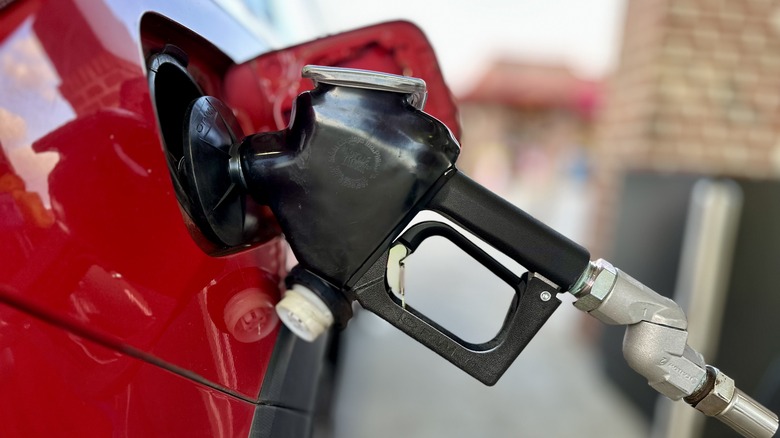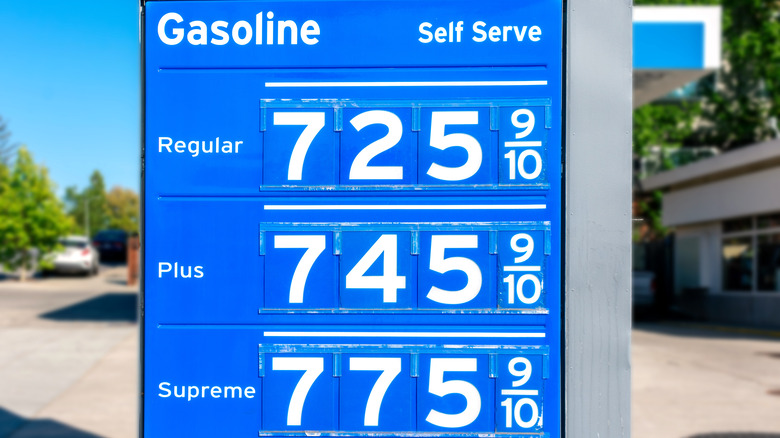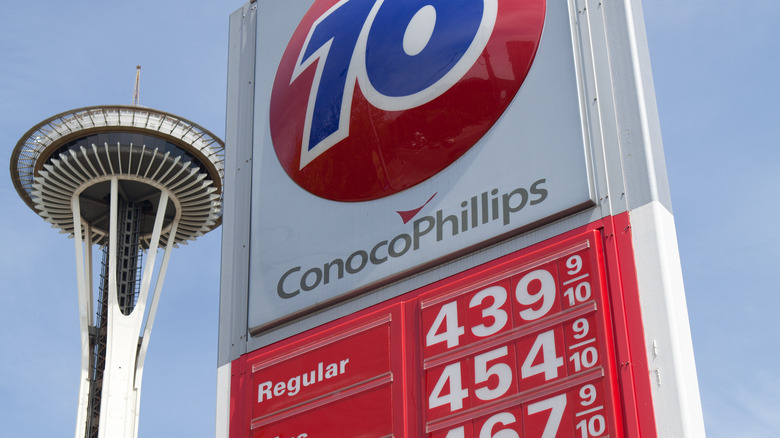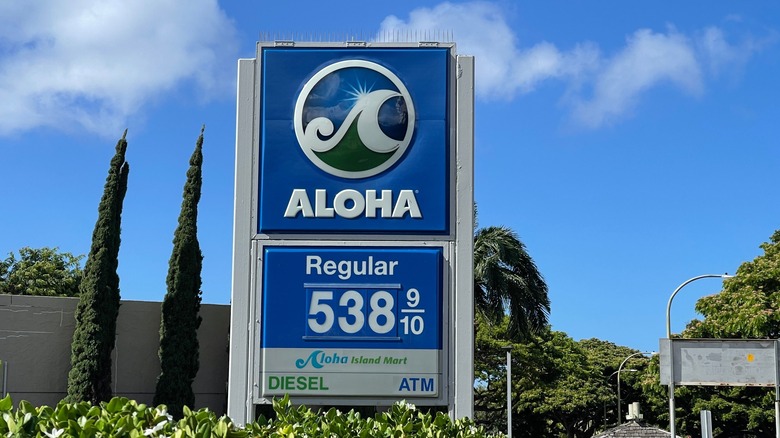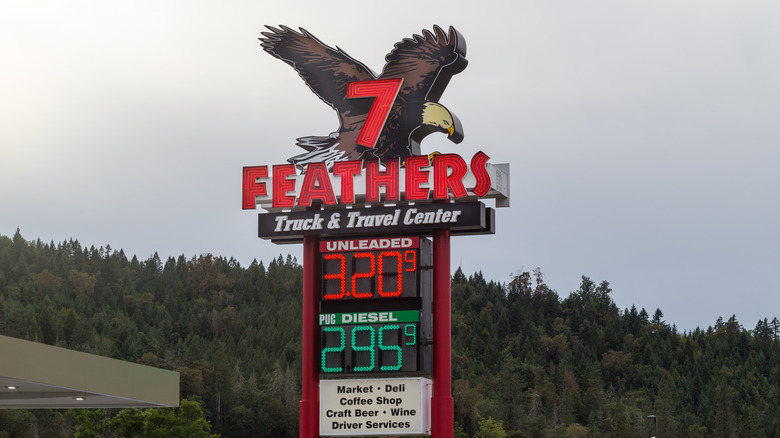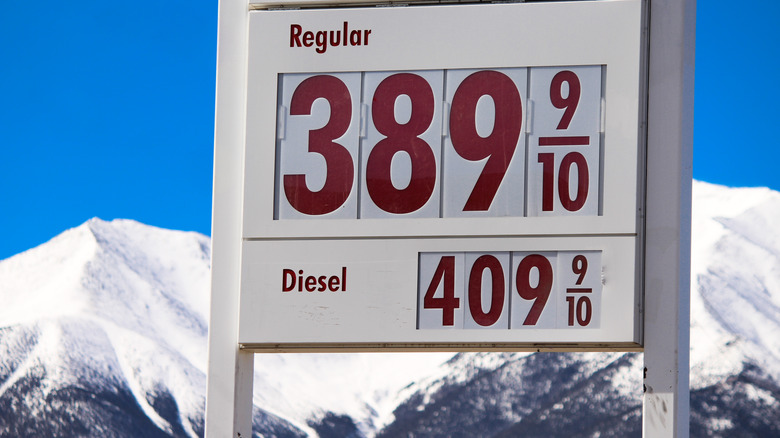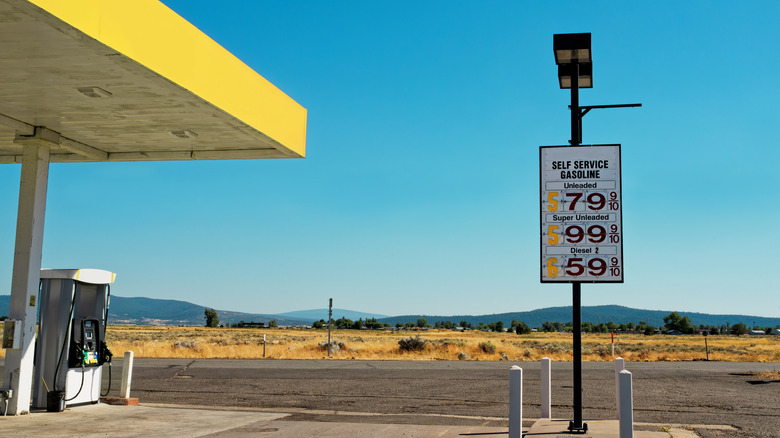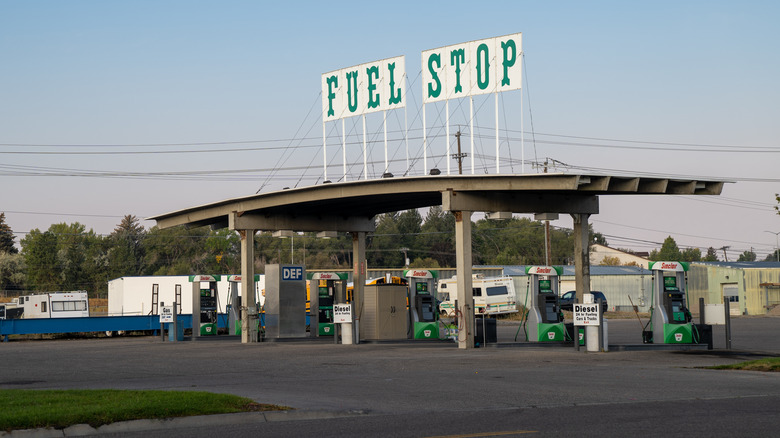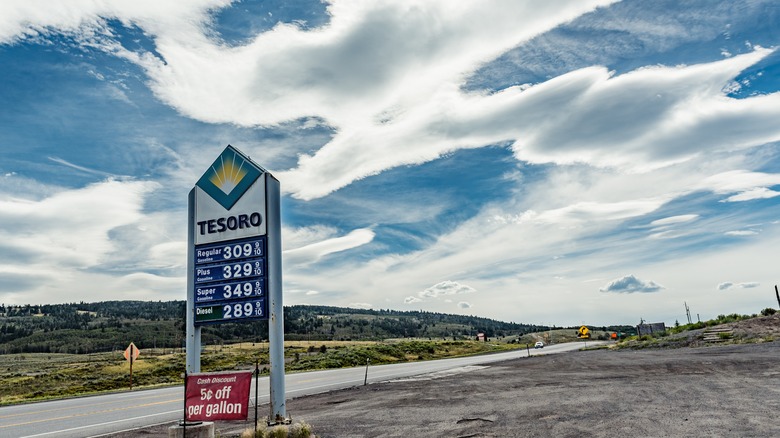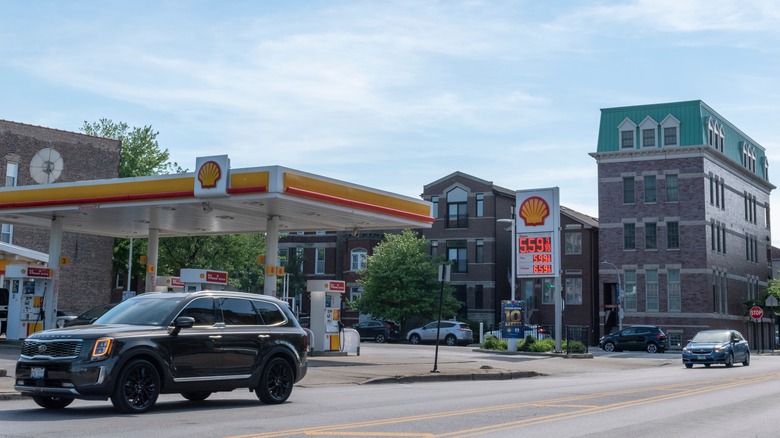The 10 States With The Absolute Highest Gas Prices
As of October 7, 2025, the national average price for a gallon of regular gas is $3.12, according to AAA's daily tracker. That's down three cents from the previous week, and eight cents from last month. A year ago, the national average was $3.17, meaning drivers are paying slightly less now than they did at this time last year. The previous U.S. record for the national average price of gasoline was $4.165 per gallon, set back in July 2008. That mark stood for nearly 14 years until March 2022, when prices reached $5.107 per gallon, before easing downward later that year. Even with that decline, gas prices remain high compared to historic norms.
But averages don't tell the whole story. Gas prices vary widely across the United States, and where you live can make a big difference in what you pay at the pump. On the West Coast, states such as California and Washington consistently rank at the top with the highest prices. At the same time, drivers in the South and Midwest, places like Oklahoma and Mississippi, often enjoy the cheapest fill‑ups. These differences come from a mix of factors, including taxes and fees, distribution and marketing, refining costs, and crude oil prices.
For families, these price swings affect weekly budgets, especially when factoring in the type of car they own. For businesses, they impact shipping costs, delivery fees, and even the price of groceries. And for travelers, knowing where gas is most expensive and where it's cheapest can help plan road trips more wisely. These states have the absolute highest gas prices according to AAA, along with why some states consistently rank at the top and how their prices compare to the national average.
California
California consistently leads the nation with the highest average gas price, and the gap since 2015 has grown significantly. At $4.655 per gallon, Californians are paying more than $1.53 above the national average. A month ago, the average was $4.616, and a year ago it was $4.678, showing that California's drivers rarely see relief at the pump. Even within the state, prices vary, with residents in Mono County, which borders Nevada, paying the highest at $5.876. The lowest is Sutter County, paying $4.332.
There are several reasons why gas in California is so expensive. The state has the highest gas tax in the nation, currently 70.92 cents per gallon according to the Tax Foundation. The Golden State's environmental compliance programs, such as the Cap‑and‑Trade Program and the Low Carbon Fuel Standard, add as much as $0.54 per gallon. California also requires a special cleaner-burning gasoline blend to meet its strict environmental standards, which is more expensive to produce and is made almost exclusively by in-state refineries. Because refiners outside California rarely produce this blend, the state is heavily dependent on its own limited refining capacity. This fragile supply chain means that any disruption can cause sharp price spikes.
Geography makes the market even tighter. Unlike states in the Midwest or Gulf Coast, California is isolated from the rest of the U.S. fuel network, with no pipelines crossing the Rockies and only limited connections to the Gulf Coast. Imports from overseas are possible, but high shipping costs typically limit them to periods of refinery outages or peak summer demand. As a result, many Californians have turned to hybrid and electric vehicles, and The U.S. Energy Information Agency notes the state leads the nation in EV adoption.
Washington
Washington ranks second with an average gas price of $4.508 per gallon, which is $1.39 higher than the national average. A month ago, Washington drivers were paying around $4.447, and a year ago the average was closer to $4.029. Residents in King County, where Seattle is located, pay the highest in the state at $4.807. Residents in Yakima County pay the least, at $4.255.
Like California, gas supplies on the West Coast are extremely limited. Additionally, the state has recently passed a 6-cent gas tax increase. Washingtonians now pay 55.4 cents per gallon in state taxes, according to KIRO. Washington has a cap-and-invest program designed to reduce carbon emissions, which has added approximately 40 cents to the cost of gas. Geography also plays a large role. Like California, Washington is part of the West Coast fuel market, which is relatively isolated from the rest of the country in terms of gasoline supply.
The state's crude oil supply primarily comes from Alaska and Canada, which is more expensive than sourcing from the Gulf Coast or Southeast. Mountain ranges block easy pipeline transport, so Washington relies heavily on its five in‑state refineries to turn crude oil into gasoline. When they undergo maintenance or face disruptions, prices spike quickly. Seasonal demand, especially during summer travel months, adds further pressure. For residents, the high prices have encouraged greater interest in electric vehicles and public transportation. Washington has one of the highest EV adoption rates in the nation, supported by state incentives and a growing charging network.
Hawaii
Hawaii's gas prices rank third with an average of $4.483 per gallon, approximately $1.36 higher than the national average. A month ago, prices were around $4.469, and a year ago, they were closer to $4.583. The highest prices in the state are in the county of Kauai, with residents paying $4.976 per gallon. Residents of Oahu pay the lowest in the state at $4.416.
Not surprisingly, the primary reason for Hawaii's high gas prices is its geography. Hawaii has no petroleum extraction and must import all its crude oil and refined fuels, such as gasoline and jet fuel, from other sources. Because the islands are so far from mainland refineries, transportation expenses add a premium to every gallon sold. The state also has limited storage capacity, which means it cannot stockpile large reserves to cushion against global price swings. The state excise tax on gasoline is 18.5 cents per gallon, according to the Tax Foundation, the second-lowest in the U.S. However, each county can set its own tax rate, and an additional 4% general excise tax applies to the sale of gasoline.
For residents, high gas prices are a fact of life. Businesses, especially those dependent on tourism, face higher costs for everything from airport shuttles to rental cars. Visitors often notice the high prices immediately, which can affect how much they drive while on vacation. Hawaii's situation is unique because of its isolation, but it highlights how geography can be just as important as policy in shaping fuel costs. Even if global oil prices fall, Hawaii's drivers will always pay more simply because of where they live.
Oregon
Oregon ranks fourth with an average of $4.131 per gallon, about $1.01 above the national average. A month ago, prices were around $4.067, and a year ago they were closer to $3.668. Like its West Coast neighbors, Oregon consistently pays more than most of the country. The highest prices in the state are in the county of Harney, with residents paying $4.377 per gallon. Residents of Baker pay the lowest in the state at $3.594. Harney County's prices are typically higher due to its remote location, which increases transportation costs.
Taxes are only a part of the story. Oregon's gas tax is 40 cents per gallon, according to the Tax Foundation, which is above the national average. The biggest factor is that Oregon is tied to the same isolated West Coast fuel market as California and Washington. Oregon has no refineries, and imports 90% of its gas from Washington. When refineries in the region face disruptions, Oregon drivers feel the impact.
Environmental policies also play a role. Oregon has adopted a Clean Fuels Program that requires fuel suppliers to reduce the carbon intensity of their products. While the program supports long‑term climate goals, it adds about 11.2 cents per gallon to fuel costs. Seasonal demand, especially during summer tourism, can push prices even higher. For residents, high gas prices have encouraged a greater use of public transportation in cities like Portland, as well as an increased interest in electric vehicles. Oregon offers incentives for EV purchases and has invested in charging infrastructure.
Nevada
Nevada ranks fifth with an average of $3.908 per gallon, about 79 cents above the national average. A month ago, prices were around $3.858, and a year ago they were $3,912. Nevada's prices are high, but not as extreme as those of its neighbors, California or Oregon. The highest prices in the state are in the county of Mineral, with residents paying $4.221 per gallon. Residents of White Pine pay the lowest rate in the state at $3.191. Mineral County borders Mono County in California, where prices are higher due to its remote location, making it more expensive for fuel distributors to transport gasoline to the area.
Nevada does not have any significant crude oil reserves and has only a modest amount of production. The state obtains additional petroleum products from outside the state. Las Vegas receives its gas by pipeline from refineries in Utah and Southern California, and the Reno area receives petroleum products from refineries in Northern California. Besides Las Vegas and Reno, Nevada is largely a rural state, which increases transportation costs.
The Tax Foundation pins Nevada's state gas tax is 23.81 cents per gallon, which ranks the state 40th out of 50 in terms of the lowest state gas taxes. For residents, high gas prices are especially noticeable in Las Vegas and Reno, where commuting and tourism drive demand. Visitors who rent cars or drive in from neighboring states often feel the pinch. Businesses, particularly those in logistics and hospitality, face higher costs that can affect pricing.
Alaska
Alaska ranks sixth with an average of $3.853 per gallon, about 73 cents above the national average. A month ago, prices were around $3.781, and a year ago they were closer to $3.656. At first glance, Alaska's high prices may seem surprising, given that the state is a major oil producer. The reason is due to geography and infrastructure. Most of Alaska's crude oil is exported, and the state has limited refining capacity. Fuel must often be shipped long distances within the state, especially to rural communities, which adds significant costs.
The highest prices in the state are in Haines County at $4.799. The small, isolated market in Haines does not benefit from the economies of scale seen in larger cities. The limited demand results in higher costs for suppliers, which are subsequently passed on to consumers at the pump. The lowest prices are in Matanuska Susitna at $3.598.
Alaska's state gas tax is actually the lowest in the nation at 8.95 cents per gallon, per the Tax Foundation. But the savings from low taxes are offset by the high costs of transportation and limited supply chains. For residents, especially those in remote areas, high gas prices are a major burden. Many communities rely on fuel deliveries by barge or plane, which makes prices even higher than the state average. Businesses, particularly those in the fishing, tourism, and shipping industries, face higher operating costs. Tourism, a key component of Alaska's economy, can also be impacted when visitors encounter higher travel costs.
Arizona
Arizona ranks seventh with an average of $3.518 per gallon, about 40 cents above the national average. A month ago, prices were around $3.51, and a year ago, they were closer to $3.325. Gas prices in the state are highest in Maricopa County, home to Phoenix at $3.801 and lowest in La Paz County at $2.985. Gas is more expensive in Maricopa County and less expensive in La Paz County because Maricopa County relies on gas from California. La Paz County can obtain cheaper gas from further away in states like Nevada and New Mexico, which are closer to different refineries and have a lower fuel blend.
Transportation costs also increase prices the further the gas must travel, making it more expensive in landlocked Maricopa County compared to La Paz County. Arizona's prices are influenced by its reliance on fuel from California and Texas. When California's prices rise, Arizona often feels the impact. Seasonal demand also plays a significant role, particularly during the summer when tourism and extreme heat lead to increased fuel consumption.
The state gas tax is 19 cents per gallon according to the Tax Foundation, which is the 4th lowest in the country. However, because Arizona relies on outside fuel supplies, its prices remain higher than those in many other states. For residents, high gas prices are most noticeable in Phoenix and Tucson, where commuting distances can be long. Businesses, particularly those in the trucking and agriculture industries, face higher costs that can impact pricing.
Idaho
Idaho ranks eighth with an average of $3.480 per gallon, which is about 36 cents higher than the national average. A month ago, drivers in Idaho were paying around $3.466, and a year ago, the average was closer to $3.459. While Idaho's prices are not as extreme as those in California or Washington, they remain consistently above the national average. One of the main reasons is geography. Idaho is part of the Rocky Mountain fuel market, which is smaller and more isolated than the Gulf Coast or Midwest markets. This means that when supply tightens or refineries in the region face disruptions, prices rise quickly.
The highest gas prices in the state is in Fremont County, home to a significant portion of Yellowstone, a major tourist destination. The lowest is in Lemhi County at $3.144. Idaho also relies on fuel transported from refineries in other states, so any issues in those states ripple into Idaho. Taxes are another factor. Idaho's state gas tax is 33 cents per gallon per the Tax Foundation, which is the national average. While not the highest, it adds to the overall cost. Seasonal demand, especially during summer when tourism spikes in areas like Sun Valley can also push prices higher.
For residents, high gas prices are especially challenging in rural areas where driving long distances is unavoidable. Many Idahoans rely on pickup trucks and SUVs for work and daily life, which makes fuel costs a bigger part of household budgets. Businesses in agriculture and trucking also feel the impact, as higher fuel costs raise the price of moving goods across the state.
Utah
Utah ranks ninth with an average of $3.392 per gallon, about 27 cents above the national average. A month ago, prices were around $3.292, and a year ago, they were closer to $3.47. Utah's prices are not as high as those of its West Coast neighbors, but they remain consistently above the national average. The highest gas prices in the state are in Piute County at $3.758 per gallon due to its remote location. The lowest is in Iron County at $3.286.
Utah's fuel market is shaped by its geography. Utah accounts for almost one in every 100 barrels of crude oil produced in the US and approximately 18 out of every 100 barrels produced in the Rocky Mountain region. However, Utah imports a significant portion of its oil from Canada or Mexico. When regional supply tightens, Utah's prices rise quickly. Seasonal demand is another factor, especially during winter when ski tourism increases travel to mountain resorts, and in summer when national parks draw visitors from across the country.
The state gas tax is 39.15 cents per gallon, per the Tax Foundation, the 14th highest in the nation. While not the highest, it contributes to the overall cost. Environmental factors, such as air quality regulations in the Salt Lake Valley, also influence fuel blends and pricing. For residents, high gas prices are most noticeable in rural areas where driving long distances is common.
Illinois
Illinois rounds out the top 10 with an average of $3.290 per gallon, about 17 cents above the national average. A month ago, prices were around $3.462, and a year ago, they were closer to $3.436. While Illinois does not face the same geographic isolation as West Coast states, its prices remain elevated due to taxes and regional market dynamics. The highest gas prices are in Pulaski County at $3.599. The lowest is Effingham County at $2.811.
Illinois has one of the highest combined state and local gas taxes in the country. The Tax Foundation puts the state tax alone is 66.4 cents per gallon, the 2nd highest in the country, and when local taxes are added, especially in Chicago, the total can exceed 70 cents per gallon. This makes Illinois one of the most expensive states for fuel taxes, despite its proximity to major Midwest refining hubs.
Seasonal demand, particularly during summer travel, can also push prices higher. For residents, high gas prices are most noticeable in urban areas like Chicago, where commuting and delivery costs are significant. Many households in the city rely on public transportation. Businesses, especially those in logistics and retail, must account for higher transportation expenses.
